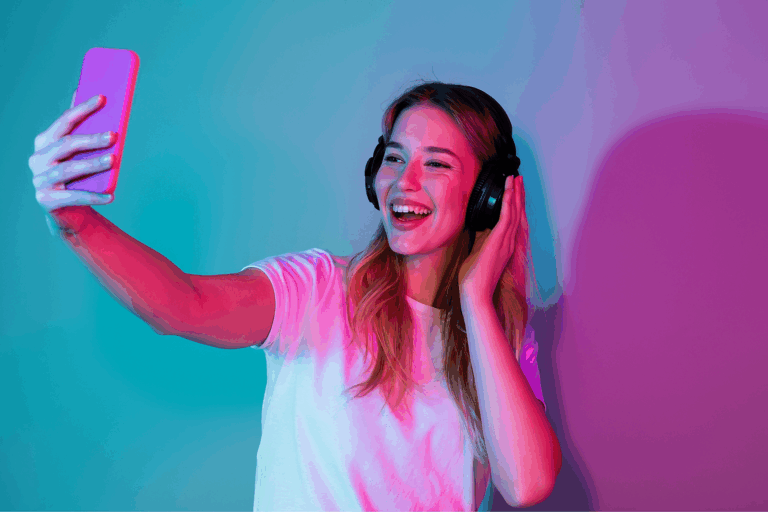TikTok vs YouTube: Which is Better for Your Business?

There’s a certain allure to video content. When produced and marketed correctly, the digestibility of this medium glues viewers to the screen. Not to mention, there’s the possibility of virality inherent in short-form video. So, with the world’s two biggest video platforms vying for the attention of consumers, which one is better suited for businesses—TikTok or YouTube?
YouTube is the second largest social media platform and search engine in the world, as deeply entrenched in our digital psyches as Google and Facebook.1 But it’s impossible to overlook the buzz around TikTok—the volume of which has reached near-deafening decibels in recent years.
Ultimately, some brands might decide to use both. But it’s important for businesses to understand each platform before choosing where to invest their video marketing efforts and dollars.
This guide on the TikTok vs YouTube debate can help brands find the insights they need to make an informed decision.
Consider the target audience’s demographics
Despite TikTok’s electric appeal, YouTube still dominates in terms of popularity. According to the latest numbers, the video platform has 2.2 billion monthly average users across the globe—more than twice TikTok’s (no-less-shabby) 1 billion.2
To phrase it differently, chances are high that a target audience turns to YouTube at least part of the time. Still, deciding which video-sharing platform should receive a lion’s share of a business’ time and resources comes down to the unique audiences each platform enjoys.
The YouTube audience
Forget the myth that YouTube exclusively attracts Boomers and Gen Xers while all the cool kids go crazy over on TikTok. YouTube’s enormous audience spans generations. On a daily basis, this is who makes up YouTube’s users:3
- 81% – 18 to 25 years
- 71% – 26-35 years
- 67% – 36-45 years
- 66% – 46-55 years
- 58% – 56+ years
In addition, visitors are also nearly split down the middle when it comes to gender: Men make up 53% of YouTube’s base, while women account for 46%.
The TikTok crowd
Ask a teen what they’re up to on their phone, and nine times out of 10 they’ll reply TikTok without raising an eye from their device. The cliché exists for a reason: The most downloaded app in the world commands the attention of roughly half of Gen Z consumers.4 Specifically:
- 62% of TikTok users are between the ages of 10 and 29 years old
- 22% of TikTok’s base is under the age of 18
- 57% of TikTok users are female, while 43% are male
Why does TikTok demand youth attention? One word: Uniqueness.
TikTok operates as a virtual canvas for creators. Within this setting, its raw, unrefined short videos produced by a huge range of people play into our increased desire for inclusion and authenticity.
It’s also super diverse. Visitors can receive a recipe and tutorial just as easily as they can savor a zany dance number. Lastly, 18 to 24-year-olds make up the largest component of contributors. And we all know that youngsters look to their peers for everything from new slang to makeup trends.
Does this mean that the social media giant is totally governed by younger generations?
Hardly.
While the video-sharing platform hasn’t been around as long as YouTube, it can still attract audiences beyond the younger demographic. People between the ages of 40 and 49 make up 20.3% of TikTok’s base—and this audience may only grow as time passes. After all, YouTube, which was first launched in 2005, has 12 years on TikTok.
Given that YouTube reaches a broader range of users on a daily and monthly basis, it might seem like a no-brainer for a brand’s marketing needs in the TikTok vs YouTube dilemma unless their target audience falls under the age of 40. YouTube vs TikTok demographics aren’t the only factor to consider, however.
Weigh engagement
When deciding on which social media platform to use, brands can compare one of the most important aspects of TikTok video vs YouTube video content. YouTube might boast more than double TikTok’s number of users, but engagement has a hand in the ways businesses can influence consumers via video.
According to Broadband Search, YouTubers spend an average of 19 minutes on the site daily as opposed to the 32 minutes users spend on TikTok per day.5 This may be one of the many reasons 37% of marketers reported they would amplify their TikTok advertising.6 True, there are fewer TikTok users overall—but they linger on the site longer, which opens up a greater chance to make an impression with them.
Assess creative content
When it comes to long-format videos, YouTube reigns.
From 75-minute vinyasa classes to two-hour-long dissections of a topic, YouTube genuinely does have it all. Not to mention the recently introduced YouTube shorts. And if part of a brand’s marketing strategy is to feature long-format videos, this is the way to go. Video content can range from:
- An “About Us” video that tells the brand’s story
- An introduction to a key new member of the team
- How-tos and tutorials
- Q & As
- A behind-the-scenes look at company culture
- Live podcasts
- Classes and courses
- The introduction of a new product or service
But what if a business can express their message in a short span of time and their content will be brief, fun and punchy? As the ruler of short-form videos, TikTok may be a wiser option. And while videos on this platform used to be exceedingly short—TikTok had a 15-second time limit upon its release in 2017—they’ve since extended the limit to three minutes.
These bite-sized videos are booming—and are considered the wave of the future, even prompting YouTube to introduce YouTube Shorts. TikTok’s extension to three minutes also gives marketers more creative liberty than it has in the past.
Evaluate ad types
TikTok and YouTube aren’t just vehicles for influencer marketing and showcasing videos of a company’s culture, products and services. They’re also—obviously—a natural space for ads. So for brands thinking of launching a video ad, here’s how the two compare:
TikTok for Business
TikTok for Business launched in 2021 to help brands build awareness. Marketers have several different ways to utilize TikTok ads:
- TopView ads
- InFeed ads
- Brand takeovers
- Branded hashtags
- Branded effects
TikTok follows a cost per mile (CPM) metric—or cost per every 1,000 views. Since TikTok ads start at $10 CPM, this can be a cost-effective measure and may be especially appealing to small businesses that are just getting their feet wet. (To better assess where they should start with TikTok for Business, brands always have the option of working with a top TikTok agency.)
For those wanting to learn how to use TikTok for business, it can be fairly simple to follow and extremely beneficial to their marketing strategy.
YouTube for Business
Advertising on YouTube is standard for marketers, partly because YouTube offers businesses a fair amount of flexibility. For example, they can opt for a swift, 6-second ad at the start of a video or a longer ad in the middle of one. The different types of ads YouTube offers include:
- Overlay ads
- Bumper ads
- Skippable ads
- Non-skippable ads
- TrueView ads
Unlike TikTok, YouTube uses the pay-per-click model, with amounts ranging from $0.10 to $0.30. To stay within budget, advertisers can set a daily cap with Google—which powers YouTube ads—to prevent sticker shock.
TikTok vs YouTube: The bottom line
YouTube’s massive number of viewers can be a goldmine for marketers. The long-form format it allows gives brands a ton of leeway to reach their audiences. It’s especially well-suited to marketers who want to display their expertise, and targeted searches help put their content in front of relevant audiences. It’s also used by nearly all demographics.
This doesn’t mean it’s without drawbacks, though:
- Unlike the raw videos that made TikTok famous, YouTube calls for higher quality videos—and the price tag that arrives with them.
- YouTube is inundated with 720,000 hours of video uploaded to the site every day.7 Standing out from the crowd and building an audience can be challenging for businesses that are fresh to the site.
TikTok is a terrific choice for a B2C company whose target audience includes millennials and Gen Z, and it may be easier to develop a following than on YouTube. TikTok has a much more casual ethos, and generating videos for the site typically requires fewer production costs.
It too, however, has some facets that might give pause:
- The brevity of TikTok videos might not be suited to a business’ video marketing goals, and its laid-back, “homemade” feel may be at odds with the brand’s image.
- If a brand’s target audience is 40 and older, they might have a lower chance of reaching them than they would on YouTube.
Get the guidance you need from the pros at Power Digital
The TikTok vs YouTube debate will likely continue to heat up as TikTok continues to attract an immense base of users—and YouTube makes strides to ensure they’re not outpaced by their younger sibling. Which one a business should ultimately choose hinges on their brand, their marketing aims and their audience.
Confirm you’re making the right choice by collaborating with the experts at Power Digital. As a tech-enabled growth firm and digital marketing agency, one of our first orders of business when working with a new client is assessing where your company stands, your target audience and the growth solutions that will bring you the results you desire.
Let us weigh in on your marketing questions and decisions—and equip you with the services you need to help your company fly high.
Sources:
- Search Engine Journal. The top 10 social media sites & platforms 2022. https://www.searchenginejournal.com/social-media/biggest-social-media-sites/#close
- Oberlo. 10 TikTok statistics you need to know in 2022. https://www.oberlo.com/blog/tiktok-statistics
- Global Media Insight. YouTube statistics 2022 (users by country + demographics) https://www.globalmediainsight.com/blog/youtube-users-statistics/#demographics
- Business of Apps. TikTok revenue and usage statistics (2022). https://www.businessofapps.com/data/tik-tok-statistics/
- Broadband Search. Average daily time spent on social media (latest 2022 data). https://www.broadbandsearch.net/blog/average-daily-time-on-social-media
- Statista. Future use of social media among marketers worldwide by platform 2022. https://www.statista.com/statistics/258974/future-use-of-social-media-among-marketers-worldwide-by-platform/
- Oberlo. 10 YouTube Statistics. https://www.oberlo.com/blog/youtube-statistics
- Meta for Business. The value of video for brands. https://www.facebook.com/business/news/value-of-video
Our Editorial Standards
Reviewed for Accuracy
Every piece is fact-checked for precision.
Up-to-Date Research
We reflect the latest trends and insights.
Credible References
Backed by trusted industry sources.
Actionable & Insight-Driven
Strategic takeaways for real results.


















